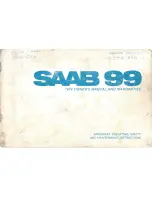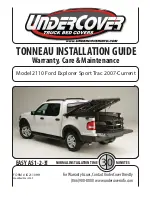
There are also some things you may want to
avoid doing because they reduce your fuel
economy:
•
Avoid sudden or hard accelerations.
•
Avoid revving the engine before turning
off the car.
•
Avoid long idle periods.
•
Do not warm up your vehicle on cold
mornings.
•
Reduce the use of air conditioning and
heat.
•
Avoid using speed control in hilly terrain.
•
Do not rest your foot on the brake pedal
while driving.
•
Avoid carrying unnecessary weight.
•
Avoid adding particular accessories to
your vehicle (e.g. bug deflectors,
rollbars/light bars, running boards, ski
racks).
•
Avoid driving with the wheels out of
alignment.
DRIVING THROUGH WATER
WARNING
Do not drive through flowing or deep
water as you may lose control of your
vehicle.
Note: Driving through standing water can
cause vehicle damage.
Note: Engine damage can occur if water
enters the air filter.
Before driving through standing water, check
the depth. Never drive through water that is
higher than the bottom of the wheel hubs.
E176913
When driving through standing water, drive
very slowly and do not stop your vehicle.
Your brake performance and traction may
be limited. After driving through water and
as soon as it is safe to do so:
•
Lightly press the brake pedal to dry the
brakes and to check that they work.
•
Check that the horn works.
•
Check that the exterior lights work.
•
Turn the steering wheel to check that the
steering power assist works.
FLOOR MATS
WARNINGS
Always use floor mats that are
designed to fit the foot well of your
vehicle. Only use floor mats that leave the
pedal area unobstructed. Only use floor mats
that are firmly secured to retention posts so
that they cannot slip out of position and
interfere with the pedals or impair safe
operation of your vehicle in other ways.
226
Navigator (TB5) Canada/United States of America, enUSA, Edition date: 201712, Second Printing
Driving Hints
















































